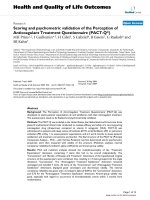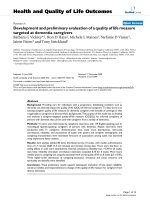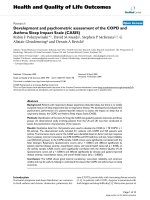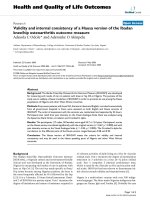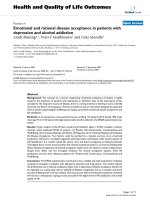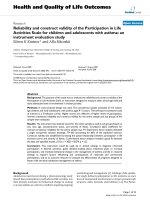Báo cáo hóa học: " Weatherability and Leach Resistance of Wood Impregnated with Nano-Zinc Oxide" pot
Bạn đang xem bản rút gọn của tài liệu. Xem và tải ngay bản đầy đủ của tài liệu tại đây (246.07 KB, 4 trang )
NANO EXPRESS
Weatherability and Leach Resistance of Wood Impregnated
with Nano-Zinc Oxide
Carol A. Clausen
•
Frederick Green III
•
S. Nami Kartal
Received: 12 April 2010 / Accepted: 1 June 2010 / Published online: 15 June 2010
Ó The Author(s) 2010. This article is published with open access at Springerlink.com
Abstract Southern pine specimens vacuum-treated with
nano-zinc oxide (nano-ZnO) dispersions were evaluated for
leach resistance and UV protection. Virtually, no leaching
occurred in any of the nano-ZnO–treated specimens in
a laboratory leach test, even at the highest retention of
13 kg/m
3
. However, specimens treated with high concen-
trations of nano-ZnO showed 58–65% chemical depletion
after 12 months of outdoor exposure. Protection from UV
damage after 12 months exposure is visibly obvious on
both exposed and unexposed surfaces compared to
untreated controls. Graying was markedly diminished,
although checking occurred in all specimens. Nano-zinc
oxide treatment at a concentration of 2.5% or greater
provided substantial resistance to water absorption fol-
lowing 12 months of outdoor exposure compared to
untreated and unweathered southern pine. We conclude
that nano-zinc oxide can be utilized in new wood pre-
servative formulations to impart resistance to leaching,
water absorption and UV damage of wood.
Keywords Nano-zinc Á Nanometal Á Leaching Á
Wood preservation Á UV degradation
Introduction
Zinc oxide has a long history as a UV stabilizer and pre-
servative component in coatings. Recent reports on
nano-zinc oxide have primarily examined zinc oxide
nanoparticles with respect to exterior coatings to improve
photostability [1, 2], as a component of UV coatings for
nanocomposites [3, 4], or modeling UV permeability of
nano-ZnO-filled coatings [5]. Relatively few reports exist
on impregnating wood with nanometals or the changes that
nanometals impart on wood durability [6, 7]. Impregnating
wood with nano-ZnO offers the advantage over nano-
coatings of long-term protection from photo-degradation
and biological deterioration, particularly if the nanotreat-
ment is leach resistant and bioactive.
Pyrolytic preparations of nanometals, such as zinc or
copper, affect several elemental characteristics such as
size, charge and dispersion properties in such a way that
may improve their properties for wood preservation com-
pared to similar soluble preparations [8]. Nanometals cre-
ated by pyrolysis demonstrate precisely controlled particle
size in the 1–100-nanometer range that may improve
penetrability of the chemical into wood relative to nano-
metals prepared by milling. Nanometer-size particles of
metals have increased surface area when evenly dispersed
in a layer. If the particle size was smaller than the diameter
of the wood window pit (\ 10,000 nm) or the opening of
the bordered pit (400–600 nm), complete penetration and
uniform distribution would be expected [9]. Nanoparticles
demonstrate high dispersion stability, but in concentrated
form, they are subject to Van der Waals forces. Surfactants
The use of trade or firm names in this publication is for reader
information and does not imply endorsement by the U.S. Department
of Agriculture of any product or service.
The Forest Products Laboratory is maintained in cooperation with the
University of Wisconsin. This article was written and prepared by
U.S. Government employees on official time, and it is therefore in the
public domain and not subject to copyright.
C. A. Clausen (&) Á F. Green III
U.S. Forest Service, Forest Products Laboratory, Madison,
WI 53726, USA
e-mail:
S. Nami Kartal
Department of Forest Biology and Wood Protection Technology,
Forestry Faculty, Istanbul University, Istanbul, Turkey
123
Nanoscale Res Lett (2010) 5:1464–1467
DOI 10.1007/s11671-010-9662-6
are typically added to increase dispersion stability thereby
enabling liquid dispersion of higher concentrations of
nanometals. Matsunaga et al. [10] conducted a study on
microdistribution of a micronized copper wood pre-
servative (10–700 nm). They observed numerous particle
deposits of copper in ray tracheids and pit lumens within
the wood. These deposits created a different microdistri-
bution pattern in wood treated with the micronized copper
than was observed in wood treated with other copper-based
preservatives. Fixation of micronized copper is believed
to occur primarily through deposition in pit chambers
and on tertiary cell wall layers rather than via chemical
reaction [9].
In a preliminary study, Clausen et al. [7] evaluated the
feasibility of nano-zinc oxide as a wood preservative. In
laboratory tests, they reported that nano-zinc oxide-treated
wood inhibited some decay fungi, but not those that are
otherwise zinc-tolerant (e.g. Postia placenta). Nano-zinc
oxide inhibited termite feeding and caused moderate ter-
mite mortality and inhibition. Nano-zinc-treated wood was
leach resistant, but weathering results were too preliminary
to draw conclusions. Here, we report on weathering char-
acteristics of southern pine vacuum-treated with nano-zinc
oxide after 12 months of exposure.
Materials and Methods
Treatment Chemicals
Nano-zinc oxide (Nanophase Technologies Corporation,
Romeoville, IL, USA) was provided as an aqueous dis-
persion containing 50% 30 nm zinc oxide particles with a
dispersant. Zinc sulfate was obtained from Mallinckrodt
Chemicals, St. Louis, MO, USA.
Specimen Treatment
Test specimens, prepared from sapwood portions of
southern pine (SP), were vacuum-impregnated with nano-
zinc oxide treatments according to American Wood
Protection Association [11] E10-08 standard method for
testing wood preservatives. Specimen size varied for
leaching and weathering tests according to American
Wood Protection Association (AWPA) and American
Standard for Testing and Material (ASTM) standard
methods. Pre-weighed specimens that were conditioned to
20°C and 65% relative humidity (RH) were vacuum-trea-
ted (45-min vacuum at 172 kPa) with aqueous solutions of
30 nm zinc oxide particles diluted in DI water to 1.0, 2.5
and 5.0% based on the metal oxide (ZnO). Zinc sulfate
(ZnSO
4
) was prepared to contain an equivalent amount of
Zn for comparison with 1.0% nano-zinc oxide for the leach
test. Untreated specimens served as controls. Treated
specimens were weighed, dried at 40°C for 3 days and
re-conditioned for 2 weeks. Some treated specimens were
ground to pass a 30-mesh screen and analyzed for zinc with
inductively coupled plasma atomic emission spectrometry
(ICP-AES) (Ultima ICP-AES instrument, Jobin–Yvon,
Inc., Edison, NJ) according to the standard method A21-00
for analysis of treating solutions [12] to determine chemi-
cal retention (Table 1).
Weathering
Treated and untreated SP specimens (7.6 9 10.2 9
1.3 cm) were weathered outdoors in Madison, WI, for
12 months and visually evaluated for UV damage (i.e.
splitting, checking and graying). Three specimens per
treatment plus untreated controls were placed horizontally
on a screened tray in direct sunlight. The specimen surface
in direct light was considered the exposed surface, and the
underside of each specimen was considered the unexposed
surface for reporting results. Water repellency was based
on beading of water on the surface of the specimen by
visual examination and water absorption was determined
by a modification of ASTM standard D 1037-96a [13].
Weathered specimens, both treated and untreated, and
unweathered southern pine were conditioned at 27°C and
80% relative humidity (RH), weighed, submerged verti-
cally in DI water for 24°h and reweighed to determine 24-h
water absorption. Weathered specimens were also tested
for zinc retention with ICP-AES (Table 1) and end grain
checks were counted for all specimens (Table 2).
Table 1 Treatment retention pre- and post-weathering
Nano-ZnO Retention
Concentration (%) Pre-weathering (kg/m
3
) Post-weathering (kg/m
3
)
1.0 1.61 1.80
2.5 3.78 2.47
5.0 12.96 5.43
Table 2 End grain checking following weathering
Nano-ZnO (%) Ave. checks (#)
0.0 30.7
1.0 43.3
2.5 31.7
5.0 40.3
Nanoscale Res Lett (2010) 5:1464–1467 1465
123
Chemical Leaching
Leaching procedures were similar to AWPA E11-06 stan-
dard method [14] and are described in detail Kartal et al.
[6]. Briefly, five specimens (19 9 19 9 19 mm) per
treatment were placed into 500-mL beakers, submerged in
100 mL of DI water and subjected to a vacuum to
impregnate the specimens with the leaching solution.
Samples were mildly agitated for 14 days, and leachates
were collected after 6 h, and 1, 2, 4, 6, 8, 10, 12 and
14 days. Leachates were analyzed for zinc with ICP-AES
and expressed as ppm zinc for the average leach rate of the
5 blocks per treatment concentration.
Results
Chemical Leaching
Figure 1 shows the leach rate of three concentrations of
nano-ZnO and 1% ZnSO
4
. In the laboratory leach test,
virtually no leaching of nano-ZnO occurred at any treat-
ment concentration, while zinc sulfate readily leached as
previously reported by Kartal et al. [6]. Pyrolytic nano-
metal preparations result in changes in charge properties,
and the resulting nanometal dispersions are subject to Van
der Waals forces [8]. Such changes in properties may
account for the low leaching of nanometals.
Weathering
Zinc oxide, a highly effective UV blocker in sunscreen
products, may serve a similar function in nanolayers to
protect wood from microbial attack and weathering. It can
be used as a UV-shielding material because of its strong
ultraviolet absorption [2]. After 12 months of outdoor
weathering, SP specimens treated with nano-zinc oxide
were visibly brighter than untreated controls particularly on
the unexposed surface (Fig. 2). Graying was significantly
diminished by the nano-zinc treatment, especially at higher
0
50
100
150
200
250
0.25 1 2
46
8101214
Time (days)
ppm Zn
Fig. 1 Leach rate of zinc from nano-ZnO (1% filled diamond, 2.5%
filled square and 5% filled triangle) and 1% ZnSO
4
(9) from SP-
treated blocks [6, 7]
Fig. 2 Weathering of nano-
ZnO treated wood after
12 months of outdoor exposure.
Unexposed surface refers to the
underside of the individual
exposed surface specimens
shown on the left
1466 Nanoscale Res Lett (2010) 5:1464–1467
123
treatment concentrations, although it was not completely
eliminated by the treatment. Specimens treated with 2.5
and 5.0% nano-ZnO showed mechanical surface changes
(i.e. fuzzing) that was not visible in the controls or speci-
mens treated with 1% concentration. Moderate checking
also occurred in all treated specimens but was more marked
in the specimens treated with 1% nano-Zn than the higher
treatment concentrations (Table 2). Water repellency rated
by visible water beading on wood surfaces only lasted for
8 weeks. Water absorption following 24-h submersion is
summarized in Table 3. After weathering for 12 months,
there was nearly 10% reduction in water absorption of
specimens treated with 1% nano-Zn, but specimens treated
with 2.5 and 5.0% nano-Zn showed a 32% reduction in
24-h water absorption compared to untreated controls
suggesting that higher concentrations of nano-ZnO provide
substantial water resistance for at least 12 months of out-
door exposure. Weathered specimens were analyzed for
ZnO depletion (Table 1). Results revealed no change in
ZnO retention in specimens treated with 1% nano-ZnO, but
specimens treated with 2.5 and 5.0% nano-ZnO showed a
loss of 65 and 58% treatment, respectively.
Conclusion
Nano-zinc oxide-impregnated SP (1.6 kg/m
3
retention)
demonstrated leach resistance in laboratory tests and fol-
lowing outdoor exposure for 12 months. Nano-zinc oxide
also protected wood from water absorption and UV
degradation for at least 12 months under conditions of
natural weathering. The surface properties of 30-nm zinc
oxide may have inhibited zinc-sensitive microbes, i.e. fungi
and bacteria, which may be partially responsible for ero-
sion, graying and deterioration of wood surfaces in out-
doors exposure. These beneficial properties of nano-zinc
oxide suggest that it should be considered as one compo-
nent in the development of new multi-component wood
preservatives.
Acknowledgment We thank Dan Foster, Chemist, for conducting
the ICP-AES analyses.
Open Access This article is distributed under the terms of the
Creative Commons Attribution Noncommercial License which per-
mits any noncommercial use, distribution, and reproduction in any
medium, provided the original author(s) and source are credited.
References
1. C. Hegedus, F. Pepe, D. Lindenmuth, D.J. Burgard, J. Coat.
Technol. Res. 5(4), 42–52 (2008)
2. Y. Yu, Z. Jiang, G. Wang, Y. Song, Holzforschung. 64 (2010).
doi: 10.1515/HF.2010.049
3. F. Weichelt, R. Emmler, R. Flyunt, E. Beyer, M.R. Buchmeiser,
M. Beyer, Macromol. Mater. Eng. 295, 130–136 (2010)
4. H. Lei, T. Xu, C. Gao, J. Coat. Technol. Res. 7(1), 91–97 (2010)
5. M.S. Lowry, D.R. Hubble, A.L. Wressell, M.S. Vratsanos, F.R.
Pepe, C.R. Hegedus, J. Coat. Technol. Res. 5(2), 233–239 (2008)
6. S.N. Kartal, F. Green III, C.A. Clausen, Int. Biodeter. Biodegr.
63, 490–495 (2009)
7. C.A. Clausen, V.W. Yang, R.A. Arango, F. Green III, Proc.
Amer. Wood Protect. Assoc. 105, 255–260 (2010)
8. C.A. Clausen, Int. Res. Group Wood Protect. 15p (2007). IRG/
WP/07-30415
9. M.H. Freeman, C.R. McIntyre, For. Prod. J. 58(11), 6–27 (2008)
10. H. Matsunaga, M. Kigushi, P. Evans, Int. Res. Group Wood
Protect. 7p (2007). IRG/WP/07-40360
11. American Wood Protection Association Standards. E10-08. In:
Ann. Book AWPA Stds. 364–372 (2008a)
12. American Wood Protection Association Standards. A21-00. In:
Ann. Book AWPA Stds. 246–249 (2008b)
13. American Society for Testing and Materials. D 1037-96a. In:
ASTM Ann. Book Stds. 4.10: 136-165 (1998)
14. American Wood Protection Association Standards. E11-06. In:
Ann. Book AWPA Stds. 373–375 (2008c)
Table 3 Water absorption of unweathered southern pine and
weathered specimens treated with nano-ZnO
Treatment (%) Water absorption
Wt.
a
Vol.
b
0.0 45.8 0.45
1.0 42.4 0.42
2.5 29.5 0.29
5.0 28.7 0.29
a
Percent by weight (g)
b
Percent by volume (g/cm
3
)
Nanoscale Res Lett (2010) 5:1464–1467 1467
123

